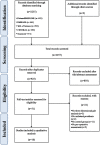Kinematic Gait Analysis After Primary Total Hip Replacement: A Systematic Review: Gait After Total Hip Replacement: A Systematic Review
- PMID: 33133399
- PMCID: PMC7573021
- DOI: 10.1007/s43465-020-00101-x
Kinematic Gait Analysis After Primary Total Hip Replacement: A Systematic Review: Gait After Total Hip Replacement: A Systematic Review
Abstract
Total hip replacement (THR) is a surgical procedure indicated for patients affected by severe hip osteoarthritis. Although this technique has proved to be effective in relieving pain and restoring function, gait limitations may persist following this procedure. The objective of this systematic review was to evaluate gait kinematics after THR and compare the results with those of the pre-operative state and with healthy control individuals. PubMed/MEDLINE, Embase, Web of Science, CENTRAL and Scopus databases were searched until December 2019. Methodological quality and internal validity score of each study were assessed using the PEDro and the Newcastle-Ottawa scales. In all, ten studies met our inclusion criteria. Following THR, statistically significant improvements were seen in dynamic hip and knee range of motion of both the affected and the contralateral limb, single-limb support time symmetry, step length, stride length, walking speed and gait pattern. However, deficits were observed in all the previous parameters, as well as in hip adduction angle in comparison with healthy subjects. In conclusion, gait patterns improve after THR in comparison with the pre-operative state, although there are deficits relative to healthy individuals.
Keywords: Arthroplasty; Gait analysis; Hip; Kinematics; Prostheses and implants; Replacement; Total hip replacement.
© Indian Orthopaedics Association 2020.
Conflict of interest statement
Conflict of interestThe author(s) declared no potential conflicts of interest with respect to the research, authorship and/or publication of this article.
Figures
Similar articles
-
Biomechanical changes and recovery of gait function after total hip arthroplasty for osteoarthritis: a systematic review and meta-analysis.Osteoarthritis Cartilage. 2018 Jul;26(7):847-863. doi: 10.1016/j.joca.2018.02.897. Epub 2018 Feb 21. Osteoarthritis Cartilage. 2018. PMID: 29474993
-
Long-term gait analysis in patients after total knee arthroplasty: A systematic review and meta-analysis.Gait Posture. 2024 Sep;113:75-98. doi: 10.1016/j.gaitpost.2024.06.002. Epub 2024 Jun 4. Gait Posture. 2024. PMID: 38850853
-
Hip resurfacing generates a more physiological gait than total hip replacement: A case-control study.Orthop Traumatol Surg Res. 2020 May;106(3):527-534. doi: 10.1016/j.otsr.2019.12.020. Epub 2020 Apr 4. Orthop Traumatol Surg Res. 2020. PMID: 32265178
-
Change in gait biomechanics after total ankle replacement and ankle arthrodesis: a systematic review and meta-analysis.Clin Biomech (Bristol). 2020 Mar;73:213-225. doi: 10.1016/j.clinbiomech.2020.01.015. Epub 2020 Jan 20. Clin Biomech (Bristol). 2020. PMID: 32044672
-
Contralateral hip and knee gait biomechanics are unchanged by total hip replacement for unilateral hip osteoarthritis.Gait Posture. 2012 Jan;35(1):61-5. doi: 10.1016/j.gaitpost.2011.08.006. Epub 2011 Sep 7. Gait Posture. 2012. PMID: 21903396
Cited by
-
In vivo analysis of hip joint loading on Nordic walking novices.J Orthop Surg Res. 2021 Oct 14;16(1):596. doi: 10.1186/s13018-021-02741-7. J Orthop Surg Res. 2021. PMID: 34649562 Free PMC article.
-
The validity and reliability of the OneStep smartphone application under various gait conditions in healthy adults with feasibility in clinical practice.J Orthop Surg Res. 2022 Sep 14;17(1):417. doi: 10.1186/s13018-022-03300-4. J Orthop Surg Res. 2022. PMID: 36104792 Free PMC article.
-
Motion acquisition of gait characteristics one week after total hip arthroplasty: a factor analysis.Arch Orthop Trauma Surg. 2024 May;144(5):2347-2356. doi: 10.1007/s00402-024-05245-1. Epub 2024 Mar 14. Arch Orthop Trauma Surg. 2024. PMID: 38483620 Free PMC article.
-
Assessment of Hip Abduction Motion Assistance Using a Single-Joint Hybrid Assistive Limb Robot: Feasibility and Safety Evaluation in Healthy Adults.J Clin Med. 2025 Jan 12;14(2):454. doi: 10.3390/jcm14020454. J Clin Med. 2025. PMID: 39860460 Free PMC article.
-
A novel and objective tool for determining total and shear joint contact forces after primary total hip arthroplasty.J Orthop. 2025 Mar 20;70:54-62. doi: 10.1016/j.jor.2025.03.028. eCollection 2025 Dec. J Orthop. 2025. PMID: 40225066
References
-
- Fortina M, Carta S, Gambera D, Crainz E, Ferrata P, Maniscalco P. Recovery of physical function and patient’s satisfaction after total hip replacement (THR) surgery supported by a tailored guide-book. Acta Biomed. 2005;76:152–156. - PubMed
-
- Gogia PP, Christensen CM, Schmidt C. Total hip replacement in patients with osteoarthritis of the hip: improvement in pain and functional status. Orthopedics. 1994;17:145–150. - PubMed
-
- Kolk S, Minten MJM, van Bon GEA, Rijnen WH, Geurts AC, Verdonschot N, et al. Gait and gait-related activities of daily living after total hip arthroplasty: a systematic review. Clin Biomech (Bristol, Avon) 2014;29:705–718. - PubMed
Publication types
LinkOut - more resources
Full Text Sources
Medical
Miscellaneous

